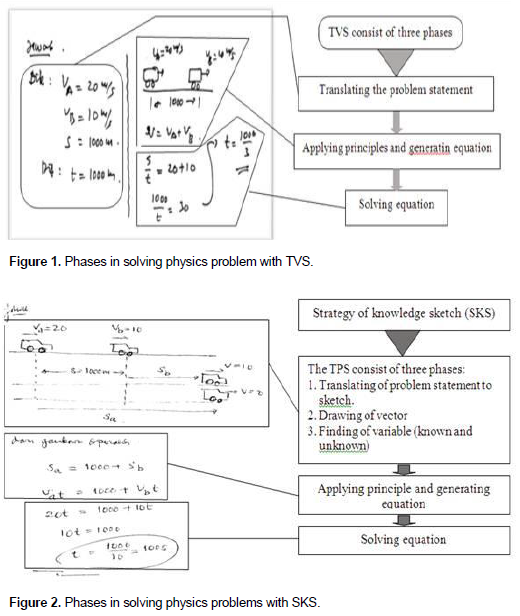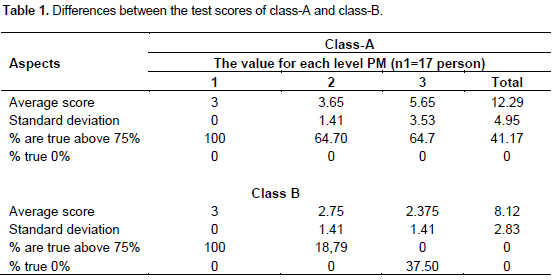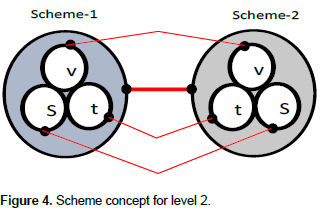Metacognitive knowledge is a necessity in starting learning process. Solving physics problems requires metacognitive knowledge which comprises factual, conceptual and procedural knowledge. The purpose of metacognitive knowledge is to train students in developing their abilities in higher order of thinking. The problem is what kind of strategies can be used by teachers to facilitate student’s comprehension? This study used "sketch knowledge strategy (SKS)" as a strategy to help students in solving high order of physics problems and its influence on their metacognitive understanding. The target variable strategy was used as a comparison in order to examine its effects. The results showed that the concept of sketch strategy was more significant in solving metacognitive problems than that of the target variable strategy.
At the beginning of the odd semester of academic year 2014/2015, metacognition knowledge ability test (MKAT) was given to the new physics education students. The intent behind this test is to obtain an idea on ​​how good the ability to understand, implement and integrate knowledge of factual, conceptual and procedural knowledge in solving physics problems. The following is an example of the test given:Two cars move in the same direction at a constant velocity, Car-B in front of car-A. The velocity of car-A is 20 m/s and car-B is 10 m/s. At t = 0 s, the distance between the two cars is 1000 m. Find the time when car-A takeover car-B. The results showed that none of the 26 new students that wrote the test answered the problems correctly. This indicates that the students have not been able to optimize their ability in cognition process. This can be seen from the solving procedure of one student (Figure 1). This procedure is similar to the strategy developed by Chi and Van Lenh (2010). One of the weaknesses of target variable strategy (TVS) is on the stage of translating the problem statement. Accordingly, TVS should be conducted independently. Research by Abdullah (2014) showed that TVS can be done through three stages, namely:
(1) Translating the problem to picture at t = 0 and t = t1
(2) Drawing the vector’s direction
(3) Finding the knowing variable so that the solution can be determined. This kind of diagnostic test is shown in Figure 2.

The inability of students to solve physics problems was a sign that some components of learning were not achieved. There is a possibility that the strategies used by teachers during learning have not been able to fulfill student’s need in solving physics problems. Teachers play important roles in the whole process of learning, hence their competence is indispensable. Based on this finding at the beginning of the first semester of 2015/2016, MKAT tests was performed on 32 physics teachers who attended master degree matriculation program at Universitas Negeri Makassar (UNM). The results showed that eight teachers (21.9%) answered the problems correctly, and the remaining 24 teachers (78.1%) failed to answer correctly. These results provided strong linkage between the failures of new students to solve MKAT problem. It was assumed that the main problems faced by physics teachers in high school was their physics subject capability. This means that teachers simply used low level of factual, conceptual and procedural knowledge (Widodo, 2008), and do not train students using complex procedural and metacognitive knowledge. However, it was seen previously that teachers do not teach their student using procedural and metacognition knowledge because they were most likely not trained on procedural and metacognitive knowledge. There is a strong linkage between schools that offer new students and LPTK that produce prospective teachers (Figure 1).
According to Suparno (2005), lecture environment in universities do not change academic behavior significantly. It means that the lecture conducted in universities that includes LPTK is predominantly on the "explanation" of the concepts and theories based on the text-book, without attempting knowledge development thinking. Abdullah and Khaeruddin (2012) opine that the lack of metacognitive knowledge of physics education courses at UNM is as a result of the lack in mastery of strategy in solving physics problems (such as high level physics problems). They know only one strategy namely target variable strategy (TVS). A research by Abdullah (2014) showed that many strategies can be used as guidance in solving problems of physics. One of these strategies is the sketch knowledge strategy (SKS). Therefore, in this study, problem-solving strategies (TVS and SKS) will be given to the 2016 graduate students of physics education in UNM. What does sketch knowledge strategy mean? Sketch knowledge strategy is a procedure in physics questions that consists of three stages:
(1) Making,
(2) Formulating, and
(3) Executing.
Making in sketch of knowledge is a term that describes the process of thinking that visualizes the statement of question and pour into a sketch completed with a description or the quantities given. Formulating is a thought process that uses principle, law and the basic formula to frame a mathematical equation based on sketch of knowledge. Executing is the use of mathematical principles to determine the parameter asked in the question. Physics problem resolution procedure is called SKS.
This research is a quasi-experiment that aims at obtaining information about the effect of sketch knowledge strategy and variable target strategy on metacognitive knowledge understanding. The subjects of this research are master students of Physics Education, State University of Makassar. The selection of subject research was predetermined by a certain group. Furthermore, the number of subjects of this study was 33 graduate students, grouped into two classes: Class A- attended by 17 students and Class-B followed by 16 students. Both classes followed the same methods, the only difference was the strategy to solve the problems. Class-A used SKS, while class-B used TVS. The variable to be studied is the effect of the SKS and TVS on the understanding of metacognitive knowledge. At the end of the teaching, both classes were given metacognitive knowledge test. This test was made in the form of essay test. There were three questions given. The questions included the level of metacognitive knowledge labeled as level-1, level-2 and level-3. The level of problem introduced by Abdullah (2014) aims to distinguish the test difficulty based on the number of equations needed to solve the problem. In this research, linear motion at constant speed and all three metacognitive knowledge was used. The test developed consists of three levels of difficulties. Henderson (2005) explained that metacognitive strategy is an activity that aims to instruct students toward arriving at the solution using the approach of the level of difficulties. Figure 3 shows the diagram level of difficulties, it is called concept scheme.

It shows the use of s = v t equation in different situation and different difficulty.
After teaching (matriculation program) as much as 5 times on the subject of Mechanics, the following topics were considered:
(1) Straight motion with constant acceleration
(2) Parabolic motion, and
(3) Force and motion.
The subjects are based on indicators of metacognitive knowledge which comprise:
(1) The factual knowledge,
(2) Conceptual knowledge, and
(3) Procedural knowledge.
During the teaching process, all students were actively involved. At the end of the teaching, both classes were given comprehension of metacognitive knowledge test. The test was developed specially for this study in the form of essays. Three tests were developed. They are tests knowledge of metacognitive level-1, level-2 and level-3, based on a test developed by Abdullah (2014). The evaluation of the answer sheet was conducted and the results obtained are shown in Table 1. Furthermore, the hypothesis was tested using "t-test to determine the differences between the test scores of class-A and class-B. The results of the t-test are as shown in Table 1.


Where:
th = 2.96> t table (0,05) = 2.04
Thus it can be said that the influence of sketch knowledge strategies in teaching physics has a significant difference with the strategy of the target variable. This difference shows that the actual sketch knowledge strategy is better than the target variable strategy, particularly in improving the understanding of metacognitive knowledge of students in teaching physics. The explanation of the research results obtained is referring to the research questions formulated in the introduction. The results for the PPM test level 1 show that apparently both classes have the same ability. This is possible because the test PPM for level-1 only measured the ability to "remember and use" concepts, formulas, and procedures. The test items PPM level-1 does not require "deep thinking" to tackle the following question:
A child rides a stop escalator. The length of the ladder is 20 m. If the average speed of the child is 0.5 m/s, how long will it take to the child to the top of the stairs? (Problem PPM Level-1)
The type of question aforementioned is usually used to train a very simple formulation. Learners in junior level can easily do it. It can be said that student in research subjects, has formed the concept of velocity (v), the distance (S) and time (t), even the relationship between the three concepts through the formulation S = vt which has been embedded in their mind. The schematic diagram concepts formed in the mind of student to solve the PPM level-1 aforementioned is seen in Figure 3.
It appears from Figure 3 that the relationship between the three concepts earlier mentioned form law, rule, principle, or formulations. The relationship is necessary in solving PPM level-1. PPM level-1 does not require a very deep thought, because these concepts have formed a relationship formulation that can be used to solve the problem. Therefore, the effect of the use of sketch knowledge strategy and variables target strategy to complete the test items PPM level-1 does not have a significant difference in students. Another case is that of PPM level-2. The scores obtained showed noticeable difference. This is evident from the acquisition of the average score of the two classes. Class-A was taught using sketch knowledge strategy and is better than class-B who was taught using the target strategy variables (Table 1). This indicates that the characteristics of PPM level-2 have a fairly high level of difficulty. In other words, to resolve the problem one needs a fairly deep thought ability to link between concepts, rules, principles and formulations. Problem level-2 is:
A child is riding a moving escalator. Upon arriving on the top, the child came down. The average velocity of child relative to the ladder is 2 times the average speed of the escalator. If the time needed by the child to move upwards is 20 s. How much time is needed if the child comes down the escalator? (Problem PPM Level-2).
From the aforementioned statements about the PPM level-2 there are two cases of the child who walked on moving escalator. Both cases have different conditions. However, both cases may be connected with one another. The level of difficulty of this problem is in the ability to think of the connection between both cases. Such a capability is called "metacognition". PPM-1 level metacognition level is very low compared to PPM level-2. The picture that follows describes the process of thinking to solve the PPM-2 level. In picture-2, there are four relationships between each concept. The number of relationship depends on how many concepts that comes to mind when solving the problem. There are three relationships, namely:
(1) Relationships between concepts within a single scheme
(2) Relationships between concepts similar in the two schemes, and
(3) The relationship between schemes.
The three relationships form a hierarchy in relation with others. That is, if a student does not have knowledge of the relationships between concepts within the scheme, the next relationship will be difficult to occur in the student's thinking. Therefore, the role of teaching strategies is crucial in "training students" to understand the three relationships. In this study, it has been proven that in training students to introduce and to understand these relationships, the sketch knowledge strategy has an advantage compared to the target variable strategy. The PPM test questions that have been tested in this study are PPM-3 level. This problem has a difficulty level that is higher than PPM Level-2. The question is:
A child walks up in an escalator; he arrives at the top in the 90second. If he just stands and the escalator is moving and he arrives at the top in the 90second. How much time is needed when he runs while escalator moves? (Problem PPM Level-3)
Problem PPM level-3 consists of the three cases that have been linked with one another. To resolve this problem we are required the ability to mastery of problems at level-1, level-2 and capabilities in metacognition. Such question can only be solved by students whose level of intelligence is above average. It is not surprising that this kind of problem is used in a selection of National Science Olympiad. For more details about the complexity of this 3-level PPM, the following is shown. A schematic representation of a concept formed in the minds of students to resolve this issue is seen in Figure 3. It is clearly seen in Figure 3 that the relationship between the number of schemes and concepts in the scheme is relatively much. Every relationship requires a very deep thought. From the research results, it was obtained that teaching the concept using sketch knowledge strategy is better than the variable target strategy, especially in solving problems in PPM level-2 and level-3. This is possible because in sketch knowledge strategy, each problem trains students on how to solve the problem per scheme. It is quite reasonable since the sketch knowledge strategy has several advantages over the strategy of the target variable. The benefits of the strategy sketch knowledge in physics teaching are:
(1) To train students to use their imagination
Aspects of the sketch knowledge can train students to imagine the verbal language into a picture sketch. The sketch is not only a "picture" but it is also filled with the quantities, concepts and principles of physics. Viewed from the aspect of learning, there are three benefits of sketching knowledge (Figures 4 and 5). The advantages are:
(a) Exercising in complex thinking.
(b) Exercising the connections between facts, concepts, and principles in the mind of students.
(c) Exercising to think abstract thing.


(2) To train students to think imaginatively and then transform it into a realistic thing. Imaginative thinking is the ability to picture something in mind. Many phenomena are produced by experts, simply because of their ability to think imaginatively. Nevertheless, imaginative thinking will not be meaningful if it is not realized in reality. For instance, a painter is able to imagine and put it in the painting. Similarly, Sir Isaac Newton when he saw an apple falling from a tree. What Newton saw was a natural thing. Everyone will say "yes indeed the apple will fall", But out of millions of people at that time, only Newton considered the falling apple as an issue. Newton had ability to think imaginatively. Not only that, Newton tried to pour the imaginative thinking skills into “laws of gravity", this ability is called thinking imaginative-realistic.
(3) To train students to think logically is based on reality. In addition to the ability to think imaginatively and realistically, other ability that can be trained through sketch strategy of knowledge is "logical thinking".
Furthermore, it can be argued that the real knowledge sketch strategy is the best way to teach physics, especially to train the ability to think. Diagrammatic sketch strategy comprises knowledge of certain aspects in the development of thinking skills. This strategyy can also train students to think critically.
The SKS strategy can be used to solve physics problem. The strategy stresses the process to train student to think through the translation of problems into a form of sketch. This will enhance the ability of students to be imaginative and realistic. The more difficult the problem is, the higher the level of metacognitive knowledge.
The authors have not declared any conflict of interests.